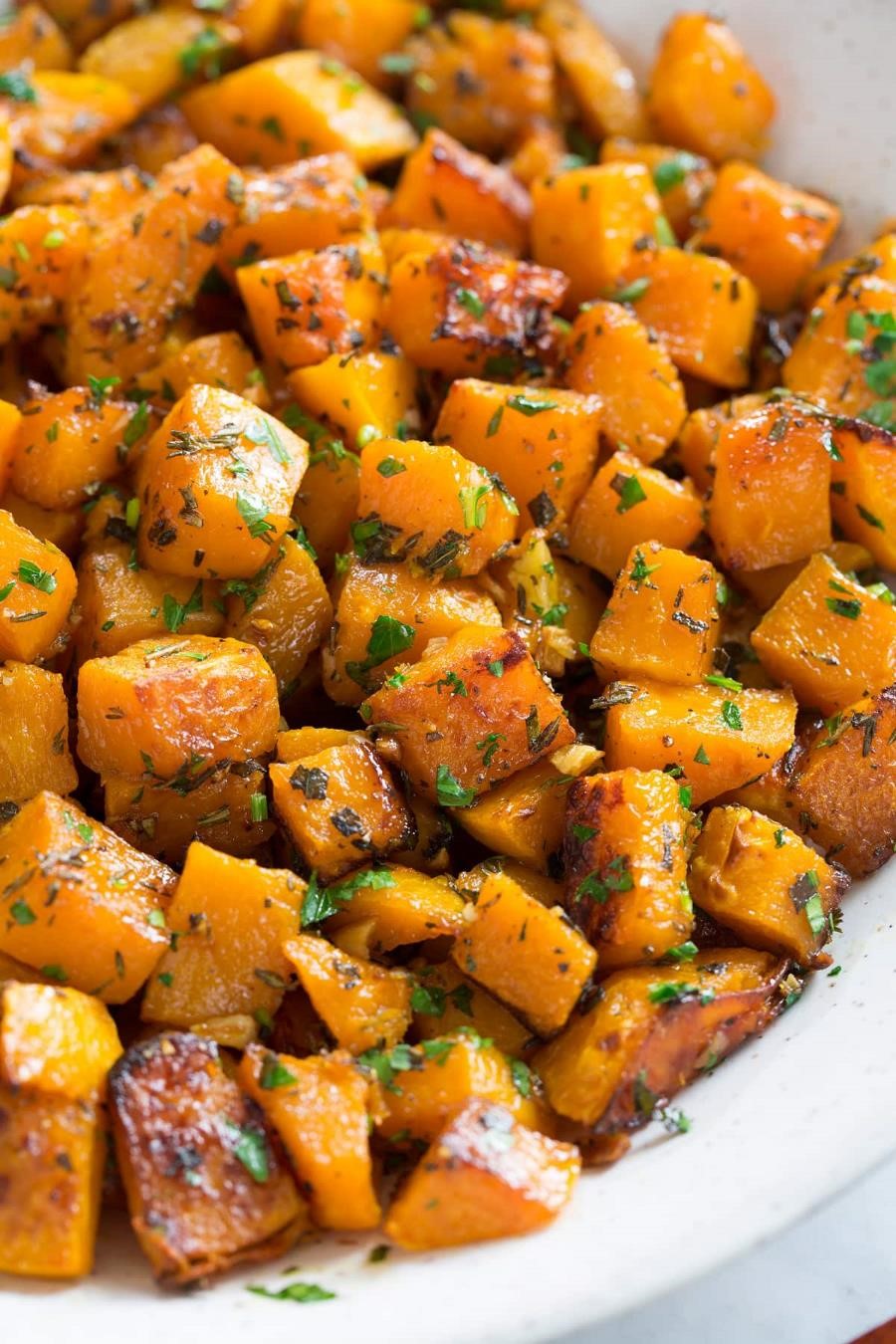Garden2Table Recipe Corner: Cookbooks and Roasted Butternut Squash Parmesan

Cassandra D’Antonio SEMG 2019
Welcome to February and some much-needed precipitation. My fellow gardeners are planning their gardens by perusing seed and gardening catalogues and prepping their beds in the hopes of perhaps a more successful or different harvest than last year. My fellow Garden2Table Committee members, who love to both garden and cook, are doing the same while likely cooking up healthy comfort foods and wondering if/when we will be active this year. Though it is rather doubtful, we are continuing to collect and test recipes so that we will be ready when it is safe to once again enter the senior centers to demonstrate those recipes. I decided to pay homage to the cookbooks that inspire us, a renown local cookbook writer, and our very own cookbook collector.
Cookbooks are to cooks what seed catalogues are to gardeners–they inspire us! Gardeners design their gardens around the different seasons, while cooks design their menus around what is in season. We often garden and cook using the instincts our experiences have taught us as guides. We tend to improvise, a lot. However, when demonstrating a recipe, it is not advisable to improvise, though we would sometimes like to. Therefore, one of our main planning tasks is to find and test recipes that are easy to prepare, use seasonal produce and common pantry items, and are both nutritious and tasty.
As experienced cooks, we are also likely to be disciples of the triangulation of fat, salt, and acid, which ensures a dish is perfectly balanced and pleasing to our 9,000 tastebuds. This is especially important when preparing meals for seniors, because as we age our sense of smell and taste changes. After 60 we lose the ability to distinguish the tastes of sweet, salty, sour, and bitter, and after 70 our sense of smell fades, exacerbating the loss of taste. Remember the revolt a few years back when the City of Albuquerque decided to remove salt and pepper shakers and other condiments from the dining rooms of senior centers? The mayor quickly ordered them replaced.
Recently, I found two forgotten vegetarian cookbooks in my small collection. Both will likely become new sources for our recipe collection. I located them after reading a couple of reviews in the WSJ and the Santa Fe New Mexican of Deborah Madison’s new book. And much to my surprise, this James Beard Award-winning author has lived in Santa Fe for the past 30 years, where she wrote most of her 14 vegetarian cookbooks.
 An Onion in My Pocket: A Life with Vegetables is Deborah Madison’s new memoir that recalls her personal history in relation to food. You won’t find any recipes in her new book, which grew out of her desire to talk about food in a different way—as a gesture of kindness and one of sharing. Considered as America’s leading authority on meat-free cooking, Ms. Madison has never liked the vegetarian label and is wary of faddish food labels; however, she does prefer to eat what is grown locally and organically and refuses to preach about it. Ms. Madison began her life as a cook at the San Francisco Zen Center and at Berkeley’s Chez Panisse under the tutorship of Alice Waters. She came to Santa Fe in 1990 very much with its local farmers’ markets in mind, and with the intent of opening a restaurant. Since that time, Ms. Madison has managed the local farmers’ market and founded the Santa Fe chapter of Slow Food (slowfoodsantafe.org). If you’re interested in finding out more about Ms. Madison’s life, career, and new memoir, visit her interview in the Santa Fe New Mexican.
An Onion in My Pocket: A Life with Vegetables is Deborah Madison’s new memoir that recalls her personal history in relation to food. You won’t find any recipes in her new book, which grew out of her desire to talk about food in a different way—as a gesture of kindness and one of sharing. Considered as America’s leading authority on meat-free cooking, Ms. Madison has never liked the vegetarian label and is wary of faddish food labels; however, she does prefer to eat what is grown locally and organically and refuses to preach about it. Ms. Madison began her life as a cook at the San Francisco Zen Center and at Berkeley’s Chez Panisse under the tutorship of Alice Waters. She came to Santa Fe in 1990 very much with its local farmers’ markets in mind, and with the intent of opening a restaurant. Since that time, Ms. Madison has managed the local farmers’ market and founded the Santa Fe chapter of Slow Food (slowfoodsantafe.org). If you’re interested in finding out more about Ms. Madison’s life, career, and new memoir, visit her interview in the Santa Fe New Mexican.
So grateful that I had not donated or given away two of Ms. Madison’s cookbooks—The Greens Cookbook and The Savory Way. Finding them reminded me of SEMG’s own cookbook collector.
Patricia Barger (SEMG 2009) is not only a prolific cookbook collector, having collected hundreds of cookbooks over the years, she is also an extraordinary gardener and a founding member of the Garden2Table Committee. For these reasons, I added an interview with her for this month’s column.
Q: During our Garden2Table demonstration training exercise a year ago, you mentioned in passing your giant cookbook collection. Because most Garden2Table volunteers love gardening, as well as cooking. We were in awe. Please describe your collection and what inspired you to become a collector?

Photo: Patricia Barger
A: My philosophy has always been that if a cookbook contains only one recipe it is worth the purchase; thus, my collection is composed of over 1597 cookbooks (yes, I have an inventory). About 75% of my cookbooks are Italian and what you would describe as “coffee table” cookbooks. I started collecting over 45 years ago when, as a young bride. I was in search of recipes for dishes my Sicilian grandmother cooked when I was a child. Like so many immigrant women of her generation, she cooked dishes her mother and grandmother cooked in the old county and the ingredients, measurements, oven temperature etc. were never written down.
Q: I just recently discovered two of Deborah Madison’s more revered cookbooks on my small shelves. How often do you peruse your collection for forgotten treasures? Do you have any of Ms. Madison’s cookbooks?
A: I peruse my collection on a regular basis for new and forgotten treasurers. However, I confess that since my shelves are bursting, I use Google searches more and more and, notoriously, rip pages out of the many magazines I subscribe to. I frequently combine several recipes and then record them in my laptop for future use if they are given the thumbs up by my family or guests. I do have some of Deborah’s cookbooks. My favorite is The Savory Way, a collection of over 300 recipes published in 1990. I like it because the recipes are flexible and forgiving, yet elegant and about half of it is devoted to some well-known chefs and their restaurants. It contains recipes for all courses of the meal and the background information is fun to read.
Q: Now that you’re retired, how does your cooking compare to that when you were a busy successful attorney? What type of meals or foods inspire you as a home chef?
A: I do more of the cooking now than when I was working. I either had a long commute or traveled a lot, so my husband did most of the cooking during the week. Sometimes I cooked on the weekends and certainly on special occasions. Since retirement, we share the cooking more evenly although I still cook for dinner parties and holidays. A Mediterranean diet is the inspiration for the way we eat, i.e., lots of vegetables, fruit, chicken, seafood and pasta with some dairy and the occasional steak or roast pork; and of course, there is room for wine and espresso coffee in moderation.
Q: I recently ran across an Albuquerque Journal article you wrote six years ago on how to welcome wildlife to your landscape and the gradual disappearance of natural open space, which we can all relate to. It must have been quite an honor to have your yard recognized by the National Wildlife Federation as a Certified Wildlife Habitat. Any updates you would like to share?
A: Since that article published, my garden has been certified as a Monarch Waystation through the Monarch Watch and the University of Kansas Entomology Program, and a Pollinator Habitat by the Xerces Society for Invertebrate Conservation. In 2016 in response to the Zika virus spread, I tried to attract bats and installed two bat houses on a 12-foot-high pole that could house up to 500 bats. It is amazing how those little guys can fold up their wings and squeeze in a small space. However, I have not had any occupants although I read that you should give them three to five years so maybe there is still hope. Four years ago, a swarm of honeybees took up residence in a whiskey barrel that decorated the northeast corner of my garden. They stayed until last spring when they left for larger accommodations – my garden certainly missed them. This experience certainly made me realize how much we rely on them and how vegetable and fruit production is affected when they are less plentiful.
Q: As a founding member of the Garden2Table Committee, which got its start demonstrating recipes at local growers’ markets rather than senior centers, would you please share a memorable anecdote or story of one of those early experiences?
A: A Santa Ana pueblo resident stopped at our demonstration in Bernalillo on our first day as we were preparing a butternut squash dish (recipe below) I quickly realized that she was very wise and had lived many years when she shared that gardening simply did not allow her to be mentally old (although she certainly appeared physically old), because gardening gave her the opportunity to realize many new hopes and dreams each season in addition to giving her something to look forward to.
While I had Patricia’s attention I asked if she would share one of her favorite plant-based, easy to prepare, comfort food recipes for a cold February day. She shared the recipe for Roasted Butternut Squash Parmesan.
ROASTED BUTTERNUT SQUASH PARMESAN
This recipe can be prepared in an oven using a lightly greased sheet pan or a frying pan. It was also one of the original recipes that Garden2Table demonstrated at the growers’ markets, and one which was created for demonstration using a variety of recipes. It was demonstrated using an electric frying pan.
Ingredients
1 medium butternut squash (about 2-½ to 3 pounds), peeled and cut into ½-inch pieces
2 tablespoons extra-virgin olive oil
1-1/2 tablespoons minced garlic (about 4 cloves)
½ teaspoon kosher salt
½ teaspoon Italian seasoning
¼ teaspoon black pepper
1 cup finely shredded Parmesan cheese
1 tablespoon chopped fresh thyme (you can also use basil, cilantro, or parsley)
Directions
- Heat frying pan to 375 degrees or an oven to 400 degrees for oven roasting.
- In a large bowl stir together the first six ingredients and ½ cup of the Parmesan Cheese.
- Spread into a single layer in the frying pan or oven sheet and roast for 10 minutes.
- Toss squash, sprinkle with remaining cheese, spread it back into an even layer.
- When squash is tender (about another 10 minutes) sprinkle with thyme and serve.
